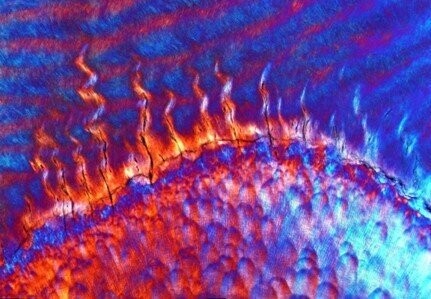On the Cusp
The cusp of a human molar tooth is a wonderfully complex structure.While the mechanisms remain obscure, we can observe the behavior of enamel forming cells by the tooth material they lay down during development.In this histological thin section, the “hill” below, is the dentine of the tooth.From the surface of the dentine, enamel developed upward in swirling patterns that have some relevance to the biomechanical resistance of the tooth to chewing forces.The junction between enamel and dentine is called the enamel-dentine junction, or EDJ.At tooth cusp tips this swirling phenomenon renders a tissue called “gnarled enamel” for its appearance.Other characteristics observed in this image are “enamel tufts”, which are enamel deficient defects arising from the EDJ upward into enamel, which here are like flames on the surface of dentine.Color in this image arises from the employ of circularly polarized light imaging by a conventional compound light microscope.Typically, apart from their general growth trajectory away from the EDJ at cusp tips, because the enamel cells regularly swirl into and out of the plane of section, the enamel is formed in patterns that, when mineralized, reveal crystal orientations that appear in orange when in the plane of the section, or blue when passing up and down through the section.
Original width = 1.65 mm


